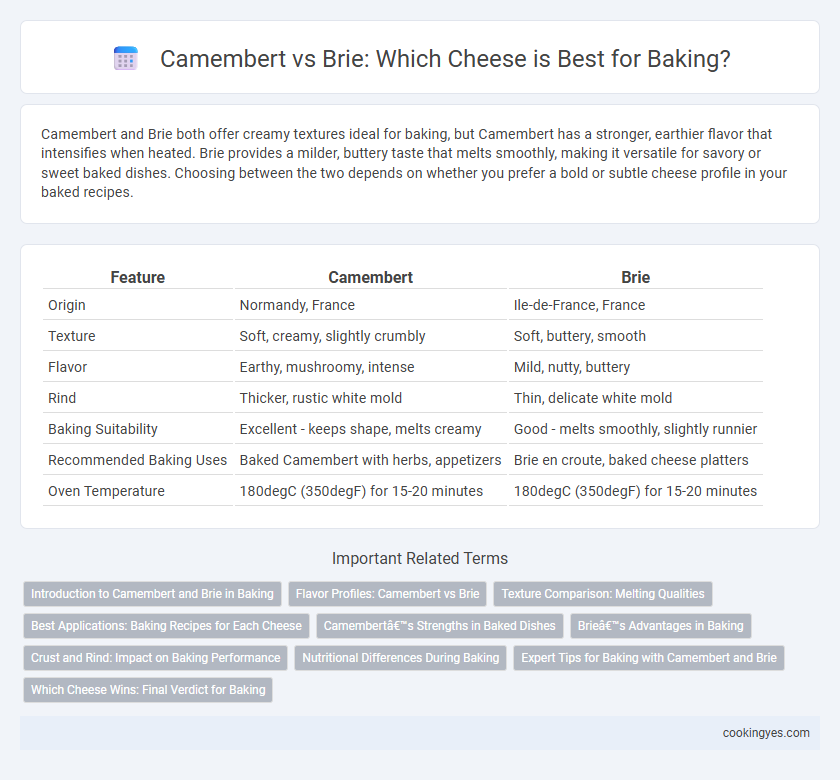Camembert and Brie both offer creamy textures ideal for baking, but Camembert has a stronger, earthier flavor that intensifies when heated. Brie provides a milder, buttery taste that melts smoothly, making it versatile for savory or sweet baked dishes. Choosing between the two depends on whether you prefer a bold or subtle cheese profile in your baked recipes.
Table of Comparison
| Feature | Camembert | Brie |
|---|---|---|
| Origin | Normandy, France | Ile-de-France, France |
| Texture | Soft, creamy, slightly crumbly | Soft, buttery, smooth |
| Flavor | Earthy, mushroomy, intense | Mild, nutty, buttery |
| Rind | Thicker, rustic white mold | Thin, delicate white mold |
| Baking Suitability | Excellent - keeps shape, melts creamy | Good - melts smoothly, slightly runnier |
| Recommended Baking Uses | Baked Camembert with herbs, appetizers | Brie en croute, baked cheese platters |
| Oven Temperature | 180degC (350degF) for 15-20 minutes | 180degC (350degF) for 15-20 minutes |
Introduction to Camembert and Brie in Baking
Camembert and Brie are both soft, creamy cheeses with white mold rinds that melt beautifully when baked, making them popular choices for cheese-based dishes. Camembert offers a stronger, earthier flavor compared to Brie's mild, buttery taste, which affects the overall flavor profile of baked recipes. Their similar textures allow them to be used interchangeably in baking, but the choice depends on whether a more intense or subtle cheese flavor is desired.
Flavor Profiles: Camembert vs Brie
Camembert offers a more intense, earthy flavor with mushroom and nutty undertones, creating a richer taste when baked compared to Brie's milder, buttery, and slightly sweet profile. Brie melts smoothly, delivering creamy textures and subtle fruity notes that enhance delicate dishes, whereas Camembert's robust aroma adds depth and complexity to savory bakes. Both cheeses share a soft, creamy interior, but Camembert's stronger flavor profile makes it ideal for bold recipes, while Brie suits lighter, more subtle culinary applications.
Texture Comparison: Melting Qualities
Camembert and Brie both offer creamy textures that enhance baked dishes, but Camembert melts more uniformly due to its higher moisture content, resulting in a smoother, more luscious finish. Brie tends to retain a slightly firmer consistency when baked, creating a contrast between its soft interior and edible rind. The choice between the two cheeses for baking largely depends on the desired melting quality and texture profile in the final dish.
Best Applications: Baking Recipes for Each Cheese
Camembert's creamy texture and rich, earthy flavor make it ideal for whole-baked recipes, where melting intensifies its soft, gooey consistency, perfect for appetizers served with crusty bread. Brie, with its mild, buttery profile, works best in baked dishes like puff pastry tarts and savory quiches, where its smooth melt complements flaky crusts without overwhelming other ingredients. Both cheeses enhance baked recipes, but Camembert provides a more robust, rustic application while Brie offers silky, subtle creaminess for delicate presentations.
Camembert’s Strengths in Baked Dishes
Camembert's creamy texture and robust earthy flavor make it ideal for baking, as it melts smoothly while retaining a pronounced depth that enhances savory dishes. Its slightly stronger aroma compared to Brie adds complexity to baked casseroles, tarts, and baked cheese platters without overpowering other ingredients. The rind's firmness also helps Camembert hold its shape during baking, delivering a perfect balance of gooey interior and tender exterior.
Brie’s Advantages in Baking
Brie cheese offers a creamier texture and milder flavor that melts smoothly, making it ideal for baking dishes like tarts and casseroles. Its higher fat content helps achieve a rich, velvety consistency without overpowering other ingredients. Brie's uniform meltability ensures even cooking and enhances the overall presentation of baked recipes.
Crust and Rind: Impact on Baking Performance
Camembert's bloomy rind develops a softer, creamier crust when baked, enhancing its meltability and producing a rich, gooey interior. Brie's thicker rind forms a sturdier crust that holds shape better under heat, resulting in a firmer texture ideal for baking whole or in slices. Both cheeses' rinds influence moisture retention and caramelization, critical factors for achieving optimal flavor and texture in baked dishes.
Nutritional Differences During Baking
Camembert and Brie exhibit subtle nutritional differences when baked, with Camembert typically offering higher protein content and a richer concentration of calcium per serving. Brie tends to have a slightly higher fat content, which can influence the texture and moisture retention during baking. Both cheeses undergo protein denaturation and fat melting processes, but Camembert's stronger protein matrix usually results in a firmer baked texture with potentially more bioavailable nutrients.
Expert Tips for Baking with Camembert and Brie
Camembert and Brie offer distinct textures and flavors for baking, with Camembert's creamy, earthy profile enhancing savory dishes, while Brie delivers a milder, buttery taste ideal for appetizers. Experts recommend scoring Camembert's rind to allow even melting and infusing it with herbs like rosemary or garlic for depth, whereas Brie benefits from wrapping in puff pastry to create a golden, crispy crust. Optimal baking temperatures range between 350-375degF (175-190degC) for 15-20 minutes to achieve a gooey interior without overcooking.
Which Cheese Wins: Final Verdict for Baking
Camembert offers a creamier texture and stronger mushroomy flavor that melts smoothly, making it ideal for rich baked dishes. Brie provides a milder taste and firmer consistency, holding shape better during baking and delivering a subtle buttery bite. For intense creaminess and pronounced flavor, Camembert wins as the preferred cheese for baking.
Camembert vs Brie for baking Infographic

 cookingyes.com
cookingyes.com